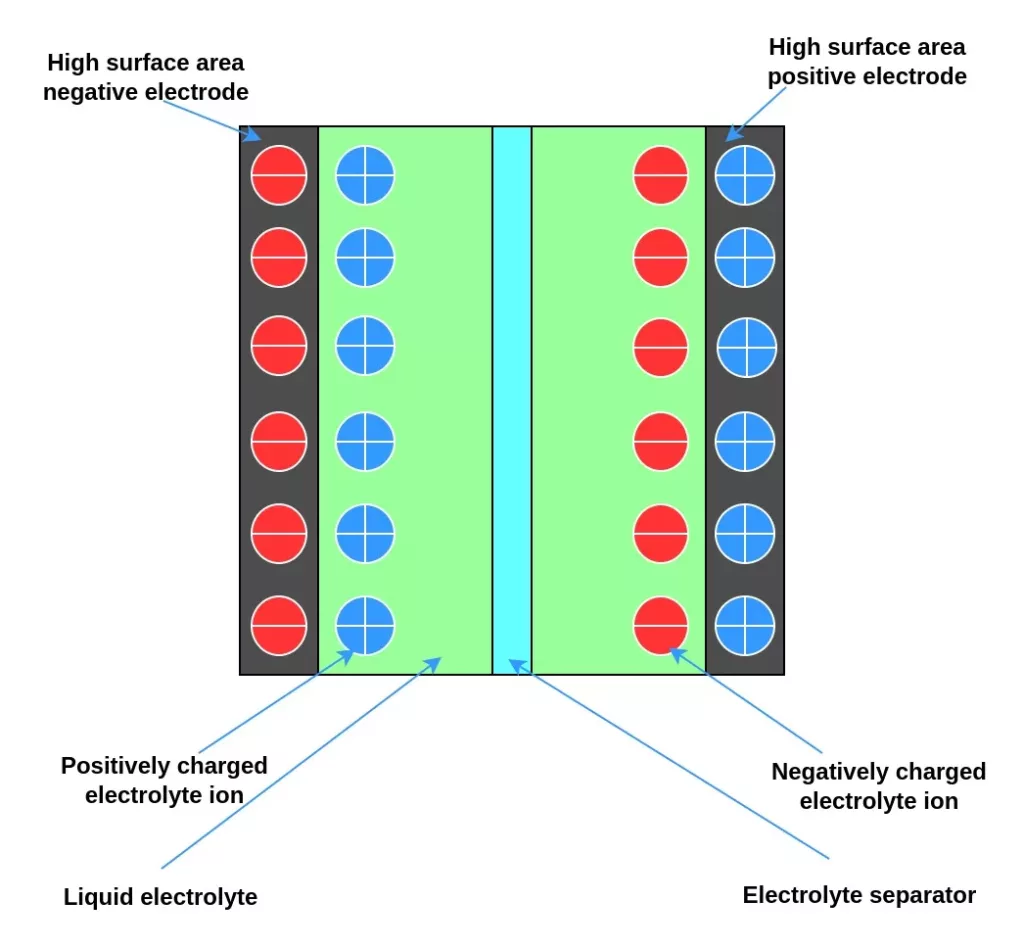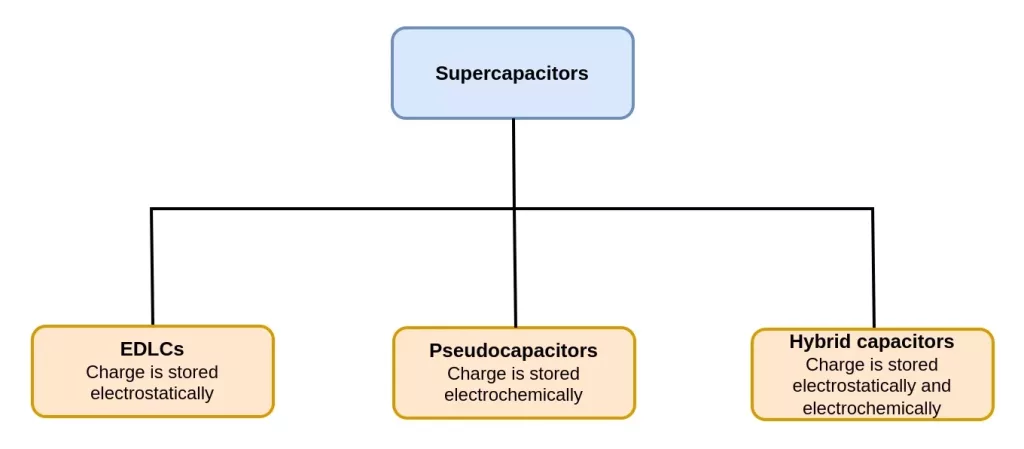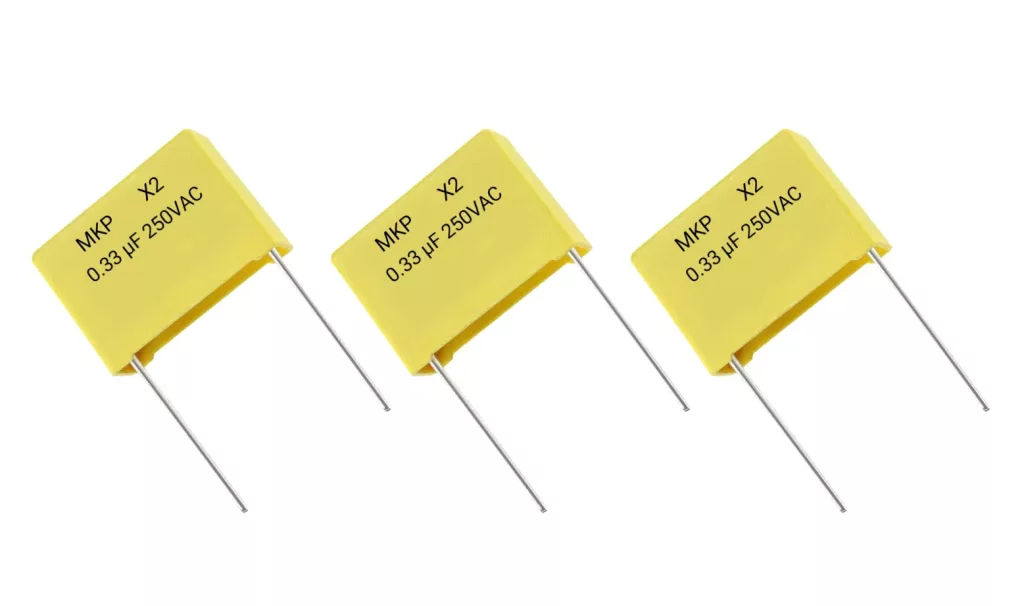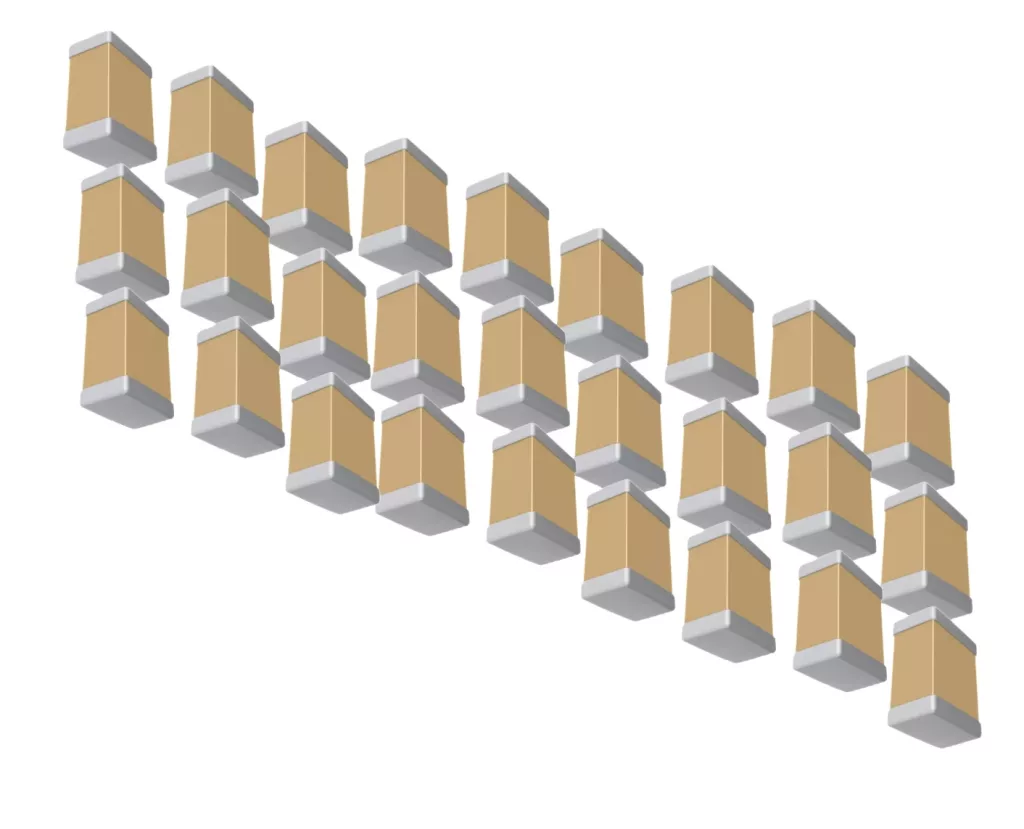Supercapacitors are revolutionary devices that challenge traditional energy storage technologies. Offering rapid energy discharge and recharge capabilities, these components bridge the gap between conventional capacitors and batteries. In this article, we explore the unique construction, properties, and applications of supercapacitors. The article also sheds light on the cutting-edge advancements propelling these devices into the spotlight of modern energy storage solutions. For other types of capacitors, see our introductory guide to types of capacitors.
Construction and properties of supercapacitors
What is a supercapacitor? A supercapacitor, also known as an ultracapacitor, boasts a distinctive construction that sets it apart from conventional capacitors and batteries. At its core, a supercapacitor consists of two porous electrodes separated by an electrolyte, forming an electric double layer. The special construction of a supercapacitor maximizes the surface area for charge accumulation and enables rapid ion movement. Figure 1 illustrates the construction of a supercapacitor.

Traditional capacitors store energy through static charge separation while batteries rely on chemical reactions. In comparison, ultracapacitors leverage electrostatic forces for quick energy exchange. The unique construction of supercapacitors contributes to their exceptional power density, rapid charge/discharge cycles, and longevity. These characteristics make supercapacitors pivotal in various applications demanding high-performance energy storage.
Supercapacitor vs capacitor
Conventional capacitors store energy through the separation of static charges on their electrodes. In comparison, supercapacitors utilize a unique construction consisting of porous electrodes and an electrolyte to form an electric double layer. This design significantly increases the surface area for charge accumulation, enabling supercapacitors to store and release energy rapidly. Consequently, supercapacitors offer much higher capacitance and power density. It is these properties of supercapacitors that make them ideal for applications requiring quick energy exchange and high-performance energy storage.
Supercapacitor vs battery
Conventional batteries store energy through chemical reactions. In comparison, a supercapacitor stores energy electrostatically. The unique design of supercapacitors allows for rapid charge and discharge cycles. While batteries typically offer higher energy density and longer-term storage, supercapacitors excel in delivering quick bursts of energy. Additionally, these capacitors endure numerous charge/discharge cycles and offer high power density. Generally, batteries are better suited for longer-term energy storage. On the other hand, supercapacitor energy storage systems excel in applications requiring rapid energy release and recharge capabilities.
Types and applications of supercapacitors
Supercapacitors can be classified into three main types based on their energy storage mechanisms:
- Electrical double layer capacitors (EDLCs)
- Pseudocapacitors
- Hybrid supercapacitors
To start with EDLC supercapacitors store energy through electrostatic charge separation. Pseudocapacitors use a combination of electrostatic capacitance and fast redox reactions at the electrode surface. Lastly, hybrid supercapacitors combine features of EDLCs and pseudocapacitors to balance power and energy density. Figure 2 shows the three classes of supercapacitors and the mechanisms they use for energy storage.

Electric double layer capacitors
EDLC supercapacitors operate based on electrostatic charge separation at the electrode-electrolyte interface. Unlike traditional capacitors that rely on dielectric materials, EDLCs store energy by forming an electric double layer. When a voltage is applied, charge carriers accumulate at the electrode surface and create an electrostatic field. This double layer of charge acts as the capacitor, enabling the rapid storage and release of energy. EDLC supercapacitors offer high power density, allowing them to deliver quick bursts of energy. This characteristic makes them ideal for applications requiring rapid charge and discharge cycles.
EDLCs exhibit excellent cycle life and can withstand a large number of charge-discharge cycles. This property makes them particularly useful in applications where frequent and rapid energy fluctuations are essential. A typical application that exploits this property is regenerative braking systems in electric vehicles or backup power supplies. However, compared to batteries, supercapacitors generally have lower energy density, limiting their suitability for long-term energy storage. Advances in materials and design continue to enhance the performance of EDLCs, expanding the applications of supercapacitors in various industries.
Pseudocapacitors
Pseudocapacitors operate on a unique energy storage mechanism, combining both electrostatic capacitance and faradaic redox reactions. Unlike electric double-layer capacitors (EDLCs), pseudocapacitors store energy through reversible chemical reactions occurring at or near the electrode surface. This characteristic allows them to achieve higher energy density compared to EDLCs, making pseudocapacitors attractive for applications requiring a balance between high power and energy storage.
In terms of construction, pseudocapacitors typically use transition metal oxides, conducting polymers, or other materials with redox-active properties as electrode materials. These materials facilitate the faradaic reactions that contribute to the additional energy storage beyond the electrostatic double layer. Pseudocapacitors exhibit faster charge/discharge rates and higher energy density compared to traditional capacitors. This makes them suitable for applications demanding a combination of rapid energy release and relatively high energy storage capacity.
Hybrid supercapacitors
Hybrid supercapacitors combine the strengths of electric double-layer capacitors (EDLCs) and pseudocapacitors. They utilizing both electrostatic capacitance and faradaic redox reactions for energy storage. This hybrid design aims to achieve a balance between the high power density of EDLCs, which provide quick charge and discharge, and the higher energy density of pseudocapacitors, which store energy through reversible chemical reactions at the electrode surface.
In terms of construction, hybrid supercapacitors typically consist of one electrode using a material suitable for double-layer capacitance, and another electrode incorporating a material capable of pseudocapacitance. This combination allows hybrid supercapacitors to optimize both power delivery and energy storage. Hybrid supercapacitors are suitable for applications that require rapid bursts of energy as well as sustained power delivery over longer durations. They offer versatility in meeting the specific requirements of diverse applications. These supercapacitors have diverse applications, ranging from portable electronics to renewable energy systems.
Applications of supercapacitors
Supercapacitors are versatile energy storage devices that excel in various applications. Whether providing reliable backup power in electronic devices or supporting grid stability in renewable energy systems, supercapacitors play a pivotal role in optimizing energy storage and delivery across diverse industries. The following are some of the common applications of supercapacitors:
- Automotive systems: there are various supercapacitor applications in electric vehicles, particularly in regenerative braking. During braking, they efficiently capture and store energy, which can be rapidly released for acceleration. This enhances the overall energy efficiency of electric and hybrid vehicles, contributing to improved performance and fuel economy. Additionally, supercapacitors excel at jump-starting, and modern vehicles commonly use supercapacitor jump starters.
- Backup power supplies: in electronic devices requiring uninterrupted operation, supercapacitors serve as reliable backup power supplies. These components ensure seamless functionality during short power outages, delivering a quick and efficient release of stored energy to maintain continuous device operation.
- Grid energy storage: supercapacitors are used in these systems to address the challenges posed by fluctuations in renewable energy sources. They support rapid charge and discharge cycles, providing stability to the electrical grid by efficiently managing variations in energy production and demand.
- Uninterruptible power supplies (UPS): supercapacitors are integrated into UPS systems to offer a short-term power bridge during electrical interruptions. Their ability to respond rapidly makes them valuable in situations where quick power backup is critical.
- Aerospace and aviation: in aerospace and aviation, supercapacitors find use for their high power density. They play a role in emergency power supplies, providing quick and efficient energy storage and release in situations where rapid power delivery is essential.
See our guide to supercapacitor applications in electric vehicles to learn more about how these components are revolutionizing automotive systems. Other applications where these capacitors are commonly used include medical devices, portable electronic systems, smart grid systems, wearable electronic systems, and renewable energy systems.
Conclusion
In conclusion, supercapacitors are remarkable energy storage devices that offer exceptional power density, rapid charge/discharge cycles, and extended longevity. Their characteristics set them apart from traditional capacitors and batteries. With applications spanning automotive systems, grid energy storage, backup power supplies, and more, supercapacitors play a pivotal role in optimizing energy storage and delivery across various industries. As technology continues to advance, the versatility and efficiency of supercapacitors position them as key components in the evolution of energy storage solutions, meeting the demands of a diverse range of applications.




Pingback: Exploring Applications of Supercapacitors in Electric Vehicles -